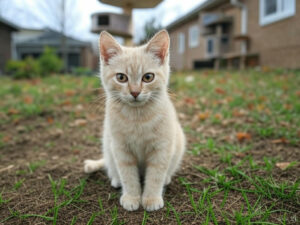Uncover the Causes of Your Cat’s Bullying by Other Cats
Is your cherished feline suffering from the distressing effects of bullying behavior? Much like humans, cats depend on positive social interactions to foster their overall emotional well-being. Unfortunately, not all feline interactions are friendly; some cats may resort to bullying as a means of asserting dominance, whether they are indoors or out in the world. Gaining insight into the complex dynamics of cat bullying is vital in helping your furry companion regain their sense of safety, security, and confidence in their environment.
While playful roughhousing can be a sign of affection, bullying in cats manifests as aggressive behaviors aimed at intimidating others. This concerning behavior goes beyond an occasional swipe or hiss; it evolves into a consistent pattern of demeaning actions. For instance, a bully cat might habitually guard food bowls or block pathways, instilling fear in their fellow felines. Promptly identifying these bullying behaviors is essential for protecting your pet’s mental health and ensuring their overall well-being, as it allows for timely intervention and support.
Taking immediate action against bullying behaviors is crucial to avert further escalation into more severe issues. A cat that falls victim to bullying may begin to avoid certain areas of the home, become increasingly withdrawn, or even refuse to use the litter box due to fear. Observable changes in behavior can indicate underlying stress and anxiety, negatively impacting your cat’s physical health and emotional stability. Early intervention is key; acting swiftly can significantly improve your chances of restoring a calm and harmonious environment for your beloved feline friend.

Identifying the Key Warning Signs That Your Cat is Experiencing Bullying
Cats may lack the verbal skills to express their feelings, but their behavior and physical condition can provide significant insights into their emotional well-being. If your feline friend is suffering from bullying behavior, you may notice several distress signals that indicate their discomfort and unhappiness. Recognizing these signs is essential for addressing any issues promptly and effectively.
On a physical level, be vigilant for telltale signs such as scratches, bite marks, or patches of fur missing, which may suggest recent confrontations with a more aggressive cat. However, it’s crucial to understand that not all symptoms will be visible. Changes in behavior are equally important indicators to monitor; a once sociable cat may become increasingly withdrawn, frequently seeking out hiding spots, or suddenly exhibit aggression that was previously absent in their demeanor. Observing these subtle changes can provide vital clues into their emotional state.
Furthermore, alterations in your cat’s eating and litter box habits can also serve as critical indicators of underlying stress. Is your cat eating less than usual or skipping visits to the litter box altogether? Such behaviors may stem from fear or anxiety, especially if a more dominant cat is obstructing access to these essential resources. Even in the safety of your home, if your furry companion appears skittish or hesitant, it could suggest a persistent sense of insecurity, as they may feel they are constantly on high alert for bullying behavior. Maintaining a watchful eye and being attentive to these subtle changes is paramount for the early detection of bullying and ensuring your cat’s overall well-being.
Understanding the Impact of Territorial Invasion: Recognizing When Bullies Enter Your Cat’s Space
Your home should serve as a sanctuary for your cat, offering them a sense of security and comfort. However, if a bully cat perceives the opportunity to invade your space, that sanctuary can quickly become a source of distress. Some cats are audacious enough to breach your property, particularly if there are accessible entry points. This scenario can transform your home from a cozy refuge into a stress-inducing environment for your resident feline.
If your cat appears anxious or fearful at home and you notice a neighbor’s cat lounging nearby, it may be time to investigate this situation more thoroughly. Bullies often exploit open doors, unsecured windows, or even cat flaps, seizing any chance to dominate your cat. You might observe your kitty avoiding certain areas of the house or becoming startled by sudden noises. These behavioral changes, although subtle, can be significant indicators of heightened stress levels and a sense of insecurity.
Understanding the implications of such intrusions is essential for preserving your pet’s emotional comfort. Once you pinpoint where security breaches are occurring, you can take proactive measures to ensure your home remains a safe zone for your cherished feline. Establishing a secure environment is fundamental to restoring your cat’s peace of mind and emotional well-being, allowing them to thrive within their own territory.

Boosting Home Security: Creating a Protective Space for Your Cat
Transforming your living space into a secure fortress for your feline companion involves sealing off entry points that bully cats often exploit. One effective strategy is to install a cat flap with selective entry features. This innovative installation allows only your cat to enter and exit freely, effectively blocking unwanted visitors from entering your home and asserting dominance over your beloved pet.
Windows can also serve as potential access points for intruders. By installing screens on windows that are frequently left open, you can deter unwanted intrusions while still allowing fresh air to circulate within your home. This way, you can maintain a comfortable and breathable environment while safeguarding your cat’s territory from potential threats.
Additionally, consider the arrangement of shared resources, such as food bowls and litter boxes. Dominant cats may attempt to assert control by blocking access to these crucial areas. It’s essential to ensure they are positioned in safe locations that allow your cat to access them without fear. By strategically distributing resources throughout your home, you can make it more challenging for a bully cat to monopolize them, effectively creating a protective shield that ensures your cat’s territory remains theirs.
Designing Safe Outdoor Spaces: Ensuring Your Cat’s Enjoyment and Security
Outdoor exploration can be a delightful experience for your cat, but it can quickly become stressful if bullies are lurking nearby. Creating safe zones in your yard can significantly alleviate your cat’s anxiety and enhance their enjoyment of the great outdoors. By taking a few thoughtful steps, you can ensure that your cat feels secure while exploring.
Consider installing cat platforms along fences or trees. These elevated spots not only provide your cat with an excellent vantage point but also offer an escape route if they encounter a more intimidating cat. Being up high can serve as a confidence booster, allowing a skittish kitty to feel more secure while surveying their surroundings.
If feasible, providing access to a shed or garage can create sheltered areas where your cat feels safe. Even a simple outdoor cat house can offer refuge from more assertive cats trying to invade their territory. These structures can foster a sense of protection and relaxation during your cat’s outdoor escapades, making their outdoor time more enjoyable and less stressful.
Additionally, incorporate landscaping elements such as potted plants or small bushes that can serve as cozy hideaways. These natural barriers not only provide peace and concealment from unfriendly neighbors but also allow your cat to enjoy their outdoor time without fear. By creating these little sanctuaries, you can ensure your cat’s outdoor experiences are both enjoyable and enriching, allowing them to explore freely.

Implementing Time-Sharing Strategies to Promote Harmony in Multi-Cat Households
Living with multiple cats in the same environment doesn’t have to feel like an ongoing struggle. The concept of “time sharing” is a fascinating strategy where cats naturally stagger their outdoor activities to avoid conflicts. This instinctual approach can serve as an effective peacekeeping method, creating a more harmonious atmosphere among your feline companions, while also reducing stress for all involved.
By understanding how this instinct operates, you can encourage your cat to utilize specific areas during quieter times, thereby reducing the chances of unwanted encounters with bully cats. For instance, feeding your cat during off-peak hours in the neighborhood can significantly minimize potential confrontations with aggressive felines, giving them a sense of security and routine.
Observe local feline activity patterns and adjust your cat’s schedule accordingly, allowing them to enjoy their favorite areas when the neighborhood is less populated. With some routine adjustments, you can guide your cat to explore the garden or yard during times when aggressive cats are likely resting, thus fostering a more peaceful coexistence and enhancing their overall quality of life.
Establishing this structured sharing of time enables each cat in the area to enjoy their surroundings without undue stress. This approach promotes a sense of harmony and significantly alleviates the need for cats to feel they must fight for every inch of territory, making shared spaces more enjoyable and peaceful for all involved.
Alleviating Outdoor Anxiety: Ensuring a Safe Toilet Experience for Your Cat
Fear can have a profound impact on your cat’s willingness to venture outdoors, even for essential activities like using the bathroom. When a bully cat is nearby, the yard can suddenly transform from a familiar space into a daunting environment, causing your feline to hesitate or avoid their usual outdoor spots altogether. This dynamic can lead to significant stress for both you and your cat.
To promote gradual re-familiarization with these safe areas, accompany your cat outside during quieter periods. This gentle approach helps them regain their confidence without the looming threat of a dominating cat shadowing their every move. Your calm presence can make a world of difference in reassuring your pet.
Consider establishing alternative toileting areas situated away from high-traffic zones that are less likely to be frequented by troublesome cats. If outdoor stress levels are too high for comfort, temporary indoor solutions may also ease the transition, ensuring your cat’s needs are continuously met without compromising their safety.
Diminishing intimidation factors is crucial, often requiring you to act like a detective in observing and narrating the neighborhood drama. By identifying the bully’s behavioral patterns and alerting your cat, you can help them gradually reclaim their territory without unnecessary confrontations. Patience and vigilance are key to helping your feline friend regain their footing and return to their old routines, transforming your garden from a battleground into a delightful paradise where they can explore freely.
The Article : Is My Cat The Victim Of Bullying Appeared First On Unity Pets.
The Article Is Your Cat a Victim of Bullying? Here’s How to Tell Was Found On https://limitsofstrategy.com




